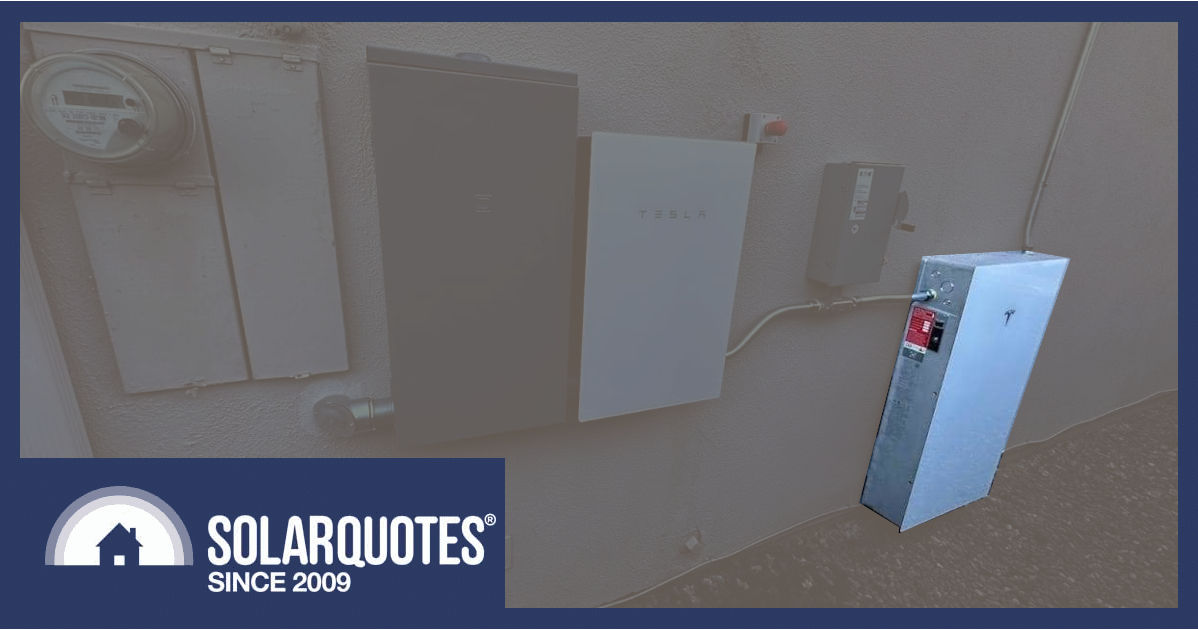
There she be… Powerwall 3
Photos are doing the rounds of a Tesla Powerwall 3 installed in the wilds of Burgeristan (the USA) , so I thought I’d add a few words to the stream of excited comments.
Update: see our latest information on the Powerwall 3 for Australia
Hopefully, my guesses are a little better-educated than some who still confuse kilowatts with kilowatt-hours. There are many people, even in the electrical and solar industry, who should know better. This is why I’m waging a private campaign to have kilowatt hours expressed as koalas instead.
Here are some of the specs from a grainy photo of the side of the Tesla Powerwall 3 battery:
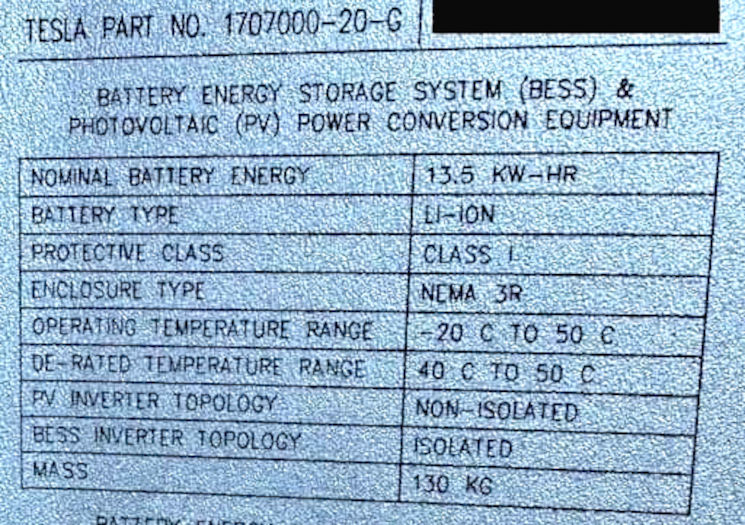
Let us be thankful the Americans don’t describe batteries in British Thermal Units or Freedom Eagle per Bushel Cubed.
Powerwall 3 Mechanical Specifications
Weight
We should start with the part that makes installers like me wince. It weighs a hefty 130kg compared to the Powerwall 2’s 114 kg1. Not everyone has a picture-perfect concrete garage and easy trailer access, so many electricians rail against this monolith-type form factor. Just imagine carrying the thing up some stairs. Some solar battery manufacturers such as Sungrow and BYD really have the competition nailed when they use scaleable stackable storage with each module weighing as little as 30 kg.
Dimensions
The Powerwall 3 takes up less wall space, but is 3cm thicker:
It has a die-cast aluminium body and glass front plate. Unless this can be removed, it suggests these units won’t be stackable like the Powerwall 2.
Electrical Specifications
Storage Capacity
13.5kWh is a decent number of koalas, matching the Powerwall 2 exactly.
Ambient Temperature Range
The temperature limit of 50°C at least makes sense in hot and sunny Australia. We don’t even have to convert it from friggenheight.
Inverter Topology
The Powerwall 2 had an integrated battery inverter. The Powerwall 3 has an integrated battery interter and an integrated solar inverter.
From an electrical perspective, it’s interesting that the Powerwall 3’s solar inverter is non-isolated, so there are only some semiconductors standing between energy sources; with smoke, fire and calamity assured if they fail. Whereas the battery inverter is isolated, so there must be a transformer in there to magnetically but not physically couple the sources.
Maybe that has something to do with American electrical rules, which also dictate rapid shutdown for solar power systems, plus metal conduit, knife switches and other stuff that’s state of the art for the twenties… the nineteen twenties.
Frequency
Just like its predecessor, the 60Hz frequency of the Powerwall 3 will be easily adjusted to an Australian 50Hz.
AC Voltage
The AC voltage matches Australian Standards well. Some people ask how something designed to suit a quaint North American 110VAC system can work in Australia. The secret is that 2Wire + Neutral + Earth means they have a split phase supply, so the 110v peasants actually have 220v in their house, but they need dedicated wiring to run things like clothes dryers.
No Three-Phase
Where this cuts both ways is that almost nobody outside an industrial factory with a dedicated street transformer has a 3-phase supply in the US. So they see no need for CCS plugs to charge EVs, and they have no market for 3-phase inverters. The upshot is that when the grid fails, PW2 has never been able to form a 3ph 120° supply, so I don’t expect Powerwall 3 will be able to offer 3-phase backup either.
Is Tesla Powerwall 3 Black Start Capable?
The other Achilles heel for PW2 was the fact they were rendered useless if the battery went flat overnight during a grid outage. Whether Powerwall 3 offers black start capability (so the unit will restart itself without the grid) is an open question, but I can’t see why it wouldn’t.
Inverter Output Power
The Powerwall 3 seems to offer 4 power configurations:
- 5.8 kVA
- 7.7 kVA
- 9.6 kVA
- 11.5 kVA
Seeing as most Australian distribution networks have a 10kW per phase limit on inverter capacity, I think we’ll get a 9.6kVA (40amp specification) if it’s not turned up to 9.999 or even 10kW.
Battery Charging Power
By the looks of it, the Tesla Powerwall 3 battery can charge at around 4.75kW, so if there’s a storm coming, you can tap the grid for a little under 3 hours to get a full charge into the battery.
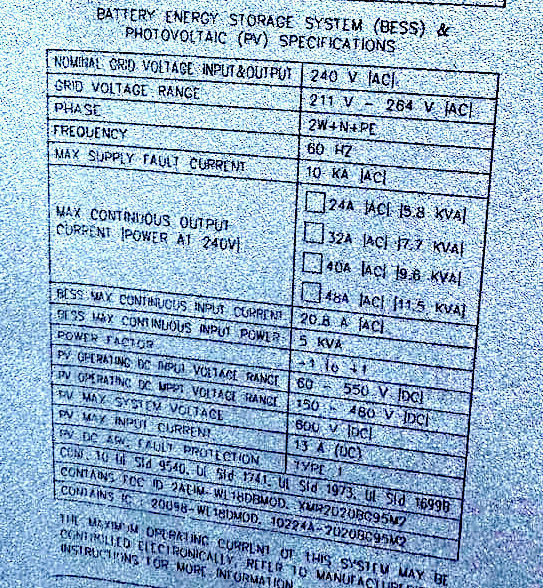
The image is a little poor but legible after some enhancement
Solar Voltage Ratings: All Good
The solar voltage ratings look to be nice and broad at 60 to 550VDC overall, so a two-panel string might be possible, but 150 to 480VDC for maximum performance is pretty standard; as is the 600VDC ceiling.
Solar Current Rating: Problematic
What genuinely surprises me though is the Powerwall 3’s 13amp DC rating. Even if that isn’t a hard limit, in the era of high current solar panels that deliver maximum power at more than 13amps nominal rating, it’s ludicrous to release a new product that doesn’t have at least a 16amp capacity.
If you apply the AS5033:2021 derating factor, which demands the inverter handles 1.25 times short circuit current, you’ll only be able to use a very limited range of 10 amp/50 volt solar panels.
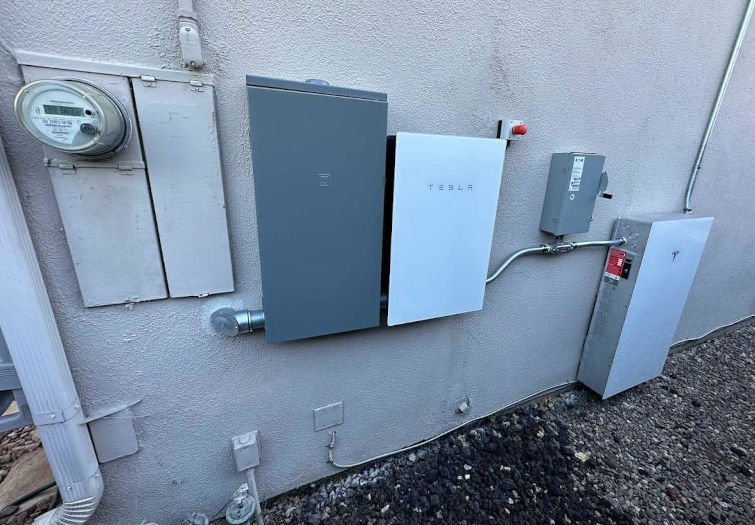
Knife switches and metal conduit, it’s as modern as apple pie. Image: Reddit
We’re Hoping For 4 MPPTs
Rumour has it that the Australian specification Powerwall 3 will come with more than the industry default of 2 solar inputs. Maybe up to 4 separate MPPTs, which would be needed to make up for the lack of current. They’d get a little closer to the outright leadership and flexibility of Fronius, who have such high ratings that they can handle double the current from parallel arrays.
Any less than 3 solar inputs will limit solar panel array sizing too much in my opinion.
Update 13 September: Tesla has confirmed the PW3 has six MPPTs. I don’t know of any solar inverters in Australia with more than 4 MPPTs.
Powerwall 3 Tweaks Required If Coming To Australia
If these images are indeed the final product, then styling has taken a back seat to substance for the Powerwall 3, maybe because the accountants have vetoed aesthetic finishes. Of course, Australian customers won’t have steel conduits to contend with.
Still, it will be interesting to see if the rapid shutdown switch makes way for an onboard DC isolator that virtually all the competition has adopted here.
Should You Wait For The Powerwall 3?
No one knows if the Powerwall 3 will even come to Australia, but if it does, what are the advantages over the Powerwall 2?
Powerwall 3 Advantages
- Integrated solar inverter with a whopping six MPPTs 🙂 but a low 13A current rating ☹️
- Higher output current – can backup more circuits with one battery.
- Takes up a little less wall area.
- Possibly cheaper (LFP battery cells are 10-20% cheaper than NMC)
Powerwall 2 Advantages
- Stackable if you want more than 13.5 kWh on the same wall area
- Looks prettier
- Easy to retrofit to 3rd party solar inverter
- Is actually available in Australia
I think it is likely Tesla will continue to make the Powerwall 2 for some time – and if you want more than 13.5 kWh of stackable storage or the flexibility of third-party solar inverters, it remains a great choice.
Footnotes
- likely due to the lower energy density of LFP cells compared to the PW2’s NMC cells ↩

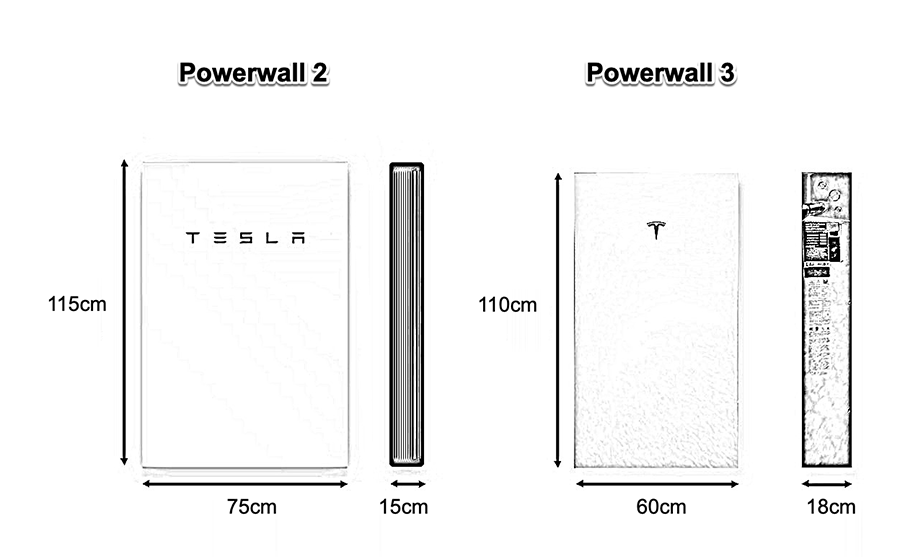
 RSS - Posts
RSS - Posts



So what, if any top quality batteries can backup a 3 phase powered home with Enphase 7A microinverters in Melbourne?
So your options are to add 3x Enphase IQ 5P, which is around $20k,
(you may have to upgrade to the IQ8 if you want off-grid or bootstrap/sunlight support (sic). But I think it’s generally compatible regardless.)
You don’t get much choice with Enphase. You get even less with 3PH, especially larger capacity batteries without adding additional hardware.
A PW2 would require moving your backup appliances to a single phase, which might be cheaper than the 3PH compatible batteries, given the cost/expenses.
Thanks for your reply. Over the past few weeks, my research found pretty much what you’ve suggested. I’m not considering anything until after November 2024, when my Vic. PFIT finishes, so there should be some first hand 5P experience stories to read in the coming months. Not even sure if 3 x 5P will work with 3 phase.
Otherwise, no stationary batteries. A Tesla Model Y instead.
Why aren’t we using Joules as an energy measurement instead? Oh yeah, time isn’t really metricated at all yet, and Joules are W/sec. So one Koala=3.6MJ, not as easy to calculate. 🙁
“13.5kWh is a decent number of koalas…”
If someone’s collecting votes, please put me down as in favour of Koala = kilowatt-hour.
North America continued using the Babylonian numbering system of numbering minutes and seconds to make the frequency 60 Hz and the incandescent light bulbs 60 watts.
The Japanese went so decimal that their line voltages are 100 and 200 volts.
And no-one is familiar with joules, except that Canadians might know a house uses 100,000,000,000 joules of gas a year in their 80,000 BTU furnace.
And we count ‘calories’ without realizing they’re actually kilocalories, but couldn’t guess at how many KW-h there might be in 2,000 calories.
Hi Randy,
1 Koala (kWh) = 3.6 MJ = 860420.65 calories = approx. 860 Kcal
Daniel Lindahl: – “Why aren’t we using Joules as an energy measurement instead?”
I’d suggest the usual convention for electrical energy traded is defined in kW·h (or MW·h or GW·h or TW·h).
1 kW·h = 3.6 MJ
Daniel Lindahl: – “Oh yeah, time isn’t really metricated at all yet, and Joules are W/sec.”
Incorrect.
The modern SI system defines the second as the base unit of time. Other units of time – minute, hour, and day – are accepted for use with SI, but are not part of SI.
https://en.wikipedia.org/wiki/Non-SI_units_mentioned_in_the_SI
Power: 1 Watt = 1 Joule per second (1W = 1 J/s)
Energy: 1 Joule = 1 Watt·second (1 J = 1 W·s)
Geoff,
You are quite right, seconds are one of the base units of the metric system. What I should have said was that time is not decimalised yet – and probably never will. The re-education of the masses would just be too painful!
If we were in the infancy of clocks and time measuring I would have proposed a second that was 14% shorter than the current one making it 100 000 seconds in a day rather than the current 86 400. A hectosec (100 newsecs) would be equivalent to a bit under a minute and a half, and a kilosec would be about a quarter of an hour – a doctor’s billable unit. there would be 100 kilosecs to a day.
Not gonna happen!
Can I introduce you to Swatch Internet Time?
https://en.m.wikipedia.org/wiki/Swatch_Internet_Time
Daniel,
I really like the line, that people are divided in two groups: those who use metric system and those who landed on the moon… Until someone pointed out, that the Saturn V rocked, which took Americans to the moon, was designed by von Braun and his team using metric system.
It all depends if the technological progress continues for a few more centuries. The advantages of metric system are indisputable: 6 basic units define everything. Moving to decimal hours is not as difficult. Already used in calculating equipment run time percentages (critically important for calculating efficiencies). What we have now are remnants of imperial system, the tailing which will disappear, system which was used during industrial revolution and the United States technological and industrial power continued. However, my bet is, that as the world is becoming more and more scientifically and technologically homogeneous, what is now happening (EU, India, China, UK, Russia coming Indonesia etc) the imperial system will die a natural death. Universities in the USA teach in both systems. We will start using decimal hours and the rest will follow. All is decided by technology, we are at the 0.78 point on the 8 point civilisation development scale, very very early.
😉 You might take a lesson from the French Republicans 😉
https://en.wikipedia.org/wiki/French_Republican_calendar:
“Each day in the Republican Calendar was divided into ten hours, each hour into 100 decimal minutes, and each decimal minute into 100 decimal seconds. Thus an hour was 144 conventional minutes (2.4 times as long as a conventional hour), a minute was 86.4 conventional seconds (44% longer than a conventional minute), and a second was 0.864 conventional seconds (13.6% shorter than a conventional second).
“Clocks were manufactured to display this decimal time, but it did not catch on. Mandatory use of decimal time was officially suspended 7 April 1795, although some cities continued to use decimal time as late as 1801.”
Although the lunar lander displayed familiar imperial units to the US astronauts, the software underneath was all written with metric units that were translated to imperial. I doubt this was because of von Braun alone – the math was just easier to write in code with only the one translation layer.
Hi Anthony. I’m excited about the powerwall 3 for the the reduced fire risk with NMC chemistry. Great article. Enjoyed it.
Will it have LFP batteries?
What no LFP battery? Why still LI ION?
They are almost certainly LFP battery cells. LFP is a sub-type of Li-ion battery.
How do you know they are LFP with almost certainty?
Sounds like this is very preliminary as a review (lots of ‘if it’s really this … ‘ etc ) which is fine. Will you do a follow up to this when the PW3 is available in Australia, Anthony?
Particularly interested in lack of support for newer panel tech – what do you think is driving that? Is the US market very different to Australian?
There is no guarantee the Powerwall 3 will make it to Australia, we may just get an Aussie version of the Powerwall+.
Hi Finn,
So if I already have emphases micro inverters, and add the current model powerwall 2, is it only a software upgrade to powerwall + or am I mistaken with this? As I was informed by a Major powerwall installation company it would only be a software upgrade when powerwall + came to Australia?
Or are they just trying to get a sale ?
Thanks
Bill
how do we know they are LFP? Other than it would be nonsensical to use anything else
“13.5kWh is a decent number of koalas…”
As long as your unit is not on the Blinky.
I wonder if PW3 can be added to the same gateway as a PW2.
Doesn’t appear so: https://www.tesla.com/support/energy/powerwall/learn/what-expect-powerwall-3#add-pw-3
Thanks for the analysis. Digressing, I love the koala. You should be so lucky in the solar business: in the caravan world they confuse energy, power, charge and current. Even my local battery shop talks in “amps per hour”!
But °Frigennheit takes the cake. Even the Burgeristan scientists use °Retrograde, which was changed by the rest of the world in 1948 to °Celsius. And so it goes…
Hi Anthony,
So if the Powerwall 3 has an inbuilt inverter with a PV input limit of 13 A would the Sunpower Maxeon 3 series (DC) be a good fit for them? It runs at 70.4V and 6.11A. This should be well under the 13 A limit?
Thanks,
Chris.
The SunPower Max 3 panels have an open circuit voltage of 81V.
That’s VERY high and would only allow 6 panels max to be installed on each of the two PW3 strings to stay under the 600Vdc limit in most locations in Australia. (Minimum temperature comes into the calculation)
That’s just 2.5kW per string if using the Max 3 415W panels !!
You can’t parallel two strings of 6x Max 3 panels together to make a 12 panel string because that would fail under the 1.25x rule Anthony mentions in the article, because of the PW3’s very low 13A input maximum.
Therefore, I say NO, SunPower Max 3 is a terrible panel for this inverter. The only panel I can find that would actually work reasonably is the REC Alpha 410W. Ten panels to a string and they comfortably fit under the Short Circuit rule (7.12A x 1.25 = 8.9A). 4.1kW per string, 8.2kW overall. Decent but not great oversizing to help charge a battery.
Anthony is spot on… the Powerwall 3 needs to be changed to accept a minimum of 16A for the Australian market. With most mainstream panels having a short circuit current of nearly 14A, the minimum spec for the Tesla PW2 should be more like 18A-20A PV Max input current.
Just to add a little footnote.
This PW3 is a hybrid inverter with a battery, not an AC coupled battery like PW2. Therefore, an entirely different product, now swimming in the same fish bowl as Fronius and BYD batteries, Sungrow and Sungrow batteries, iStore and iStore batteries, Goodwe and Goodwe batteries, Growatt and Growatt batteries, Alpha ESS… etc.
In WA, we won’t be allowed to install a PW3 at a single phase house as the ‘battery inverter’ in addition to the 5kW solar inverter. We can do that with PW2.
Why are Tesla doing this PW3….? I can only assume that they plan to sell a complete package of PW3 and solar panels to make more money, but in Australia, nobody makes money from selling solar panels…just read about Q.Cells departure in Feb 2024 here on SolarQuotes as testimony to that.
Hi,
An installer just told me that if getting a powerwall 3 (multiple of) to install at a three-phase house I’d still have to put an inverter in front of it. Is this true or is there a configuration where this doesn’t apply? It seems wasteful as I was looking at getting 2 PW3’s which would be 2 unused inverters.
I’m not sure if this has to do with blackout protection, which I’m not particularly concerned about as I haven’t had a blackout for years.
Looking for advice.. Thanks in advance!
You can add a Powerwall 3 to each phase of a 3 phase home if you really want to without a separate solar inverter, but it’s a very expensive solution that won’t work very well if you have any 3 phase loads or a 3 phase solar inverter. Consider getting a proper 3 phase battery, like Sigenergy, Sungrow or Fronius/BYD, unless I’m missing some particular requirement, I’d say they are much better solutions for your scenario.
Sorry for the later reply, I’m just getting back into this. The main reason to look at the PW is that we have 2 tesla ev’s and remaining within the same ecosystem seems to make sense to me. If I’m not worried about backup at all and mainly using to offset time of use rates then does this still hold true? Would only 2x powerwall 3s with net metering work without needing another inverter in front?
Hi Aaron,
Are you talking about 3 phase and a 3rd inverter to maintain phase balance?
Have you seen our other blogs?
https://www.solarquotes.com.au/blog/powerwall-3-tesla-training/
https://www.solarquotes.com.au/blog/powerwall-3-when-it-makes-sense/
Thanks for your reply Anthony, No, they are just saying we need a 3phase inverter for the batteries to be connected to.
From what I understand, Here in WA we have a maximum of 5kW output and the Powerwall must be export limited to 5kw. So if I have 2 units I can run on separate phases and then get 10kw output, but I’m not sure if that complies with phase balancing requirements on the 3rd phase. One installer saying it complied and another saying it doesn’t.
Hi Aaron,
I’m not familiar with the WA rules but we have a summary here. https://www.solarquotes.com.au/grid-connection/
You may have to ring Synergy or Western Power yourself for clarification.
5kW is the ceiling and they do prefer 3 phase machines as I understand it.
This article now has outdated information. The Australian Powerwall 3 has 3 MPPTs which can handle 26A, in contrast to the original with 6 MPPTs at 13A.